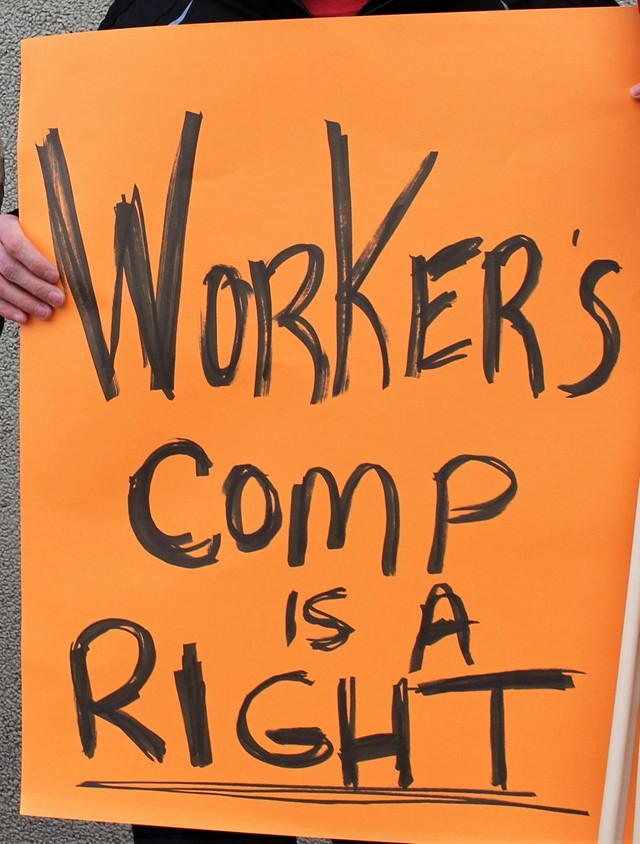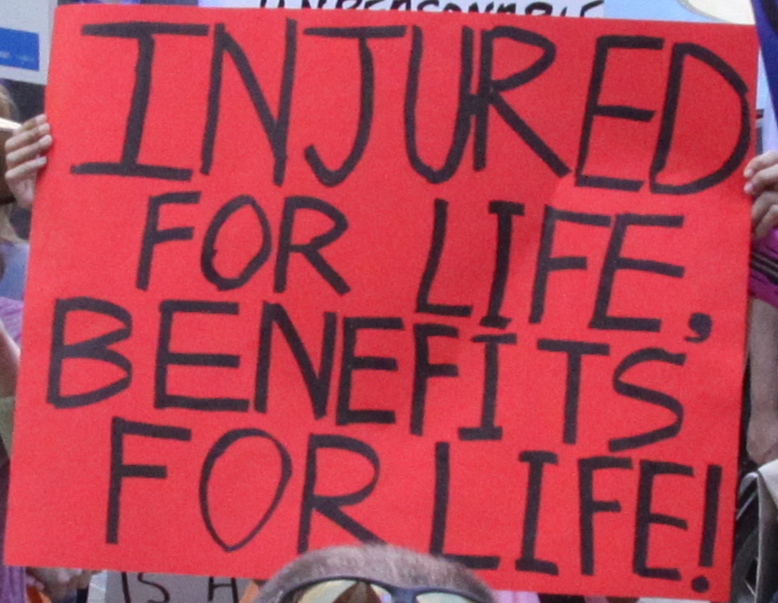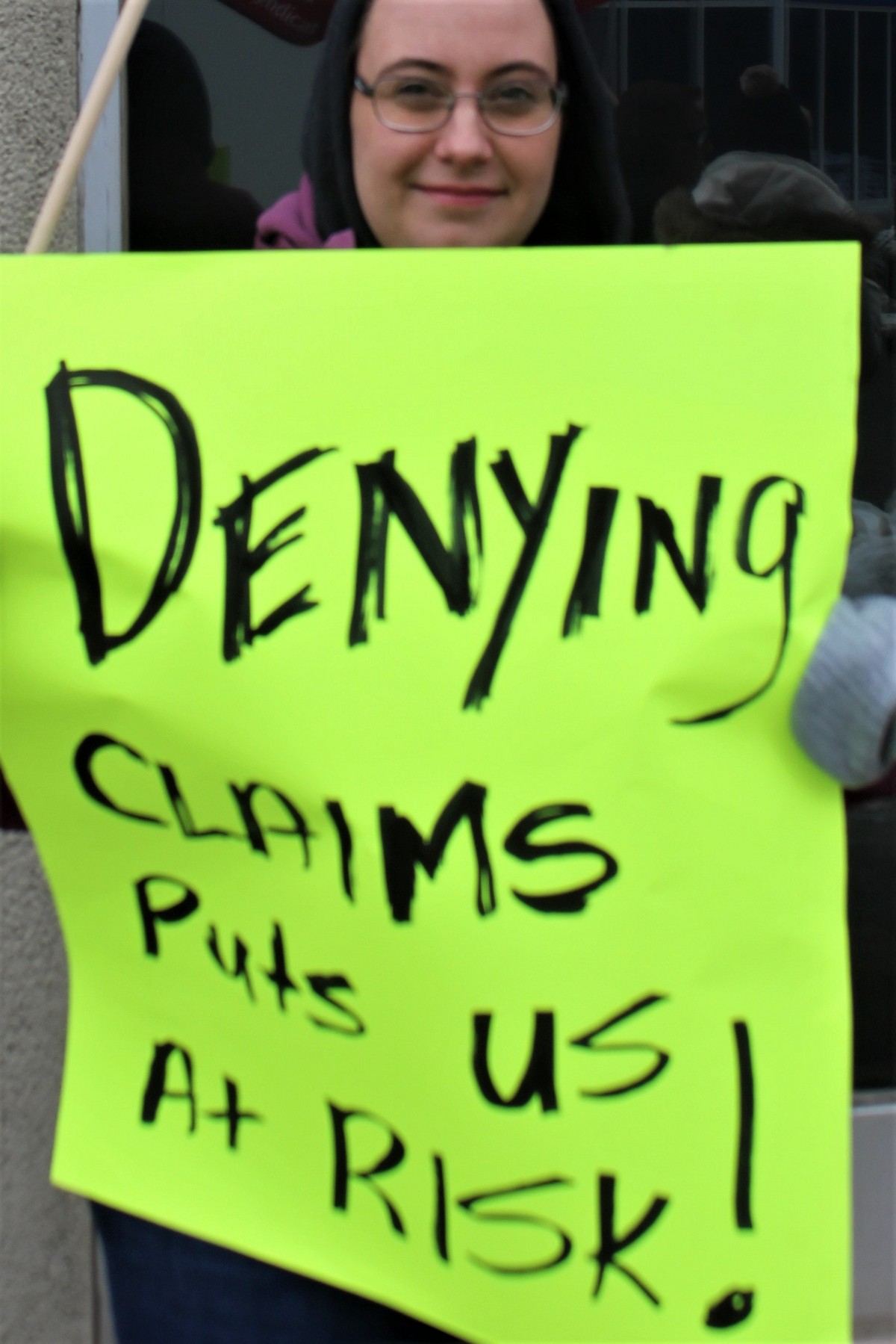|
November 5, 2021 - No. 104
People of New Brunswick Firmly Support Striking
Public Sector Workers
For a Pro-Social Solution to the
Public Services Crisis! 
March in Fredericton, November 2, 2021 as legislature opens
BC Government's Denial of Social Responsibility for Injured Workers
• Serious Problems with "No Fault" Workers' Compensation Historic Compromise
• BC Workers and Their Unions Support Just Cause of Injured Workers
For Your Information
• Ombudsperson's Recommendations and Ministry of Labour's Response
People of New Brunswick Firmly Support Striking Public Sector Workers

Fredericton, November 2, 2021
New Brunswick residents are expressing strong support for striking
public sector workers who are members of the Canadian Union of Public
Employees (CUPE NB).
 The
strike is being waged by approximately 22,000 workers who are demanding
wages they deem acceptable and essential to solving the retention and
recruitment crisis that is decimating public services. They are also
demanding the withdrawal of the government's demands for concessions
with regard to their pension plans, as centralized
negotiations had been set solely on the issue of wages The
strike is being waged by approximately 22,000 workers who are demanding
wages they deem acceptable and essential to solving the retention and
recruitment crisis that is decimating public services. They are also
demanding the withdrawal of the government's demands for concessions
with regard to their pension plans, as centralized
negotiations had been set solely on the issue of wages
CUPE NB's demonstration in front of the Legislative
Assembly in Fredericton on November 2, during the reopening of the
Assembly drew some 6,000 people, one of the largest demonstrations ever
held there. It took place at the same time as the union maintained its
picket lines province-wide. Thousands of public sector workers
came from all over the province, supported by many residents from
various backgrounds. The media reported that the demonstration was so
loud that the noise from the crowd and the speeches outside resonated
throughout the building. The demonstration began with two
processions of frontline workers, accompanied by citizens, converging
on the steps of the Legislature. Steve Drost, President of CUPE NB,
introduced the presidents of the ten striking locals, who were loudly
applauded. CUPE Maritimes Regional Director Sandy Harding invited
Premier Blaine Higgs to join her at a negotiating table set up on the
front lawn and read out the positions of the union and the government at the time the government
walked away from negotiations.
The day before, on November 1st, striking workers had visited their MPs to explain the dispute and ask for their support.
The government's dangerous anti-social attempt to use the health emergency caused by the resurgence of the pandemic to turn
the public against the striking workers has failed. CUPE NB reports
that wherever striking workers are picketing across the province,
people are coming out to express their support for them on the picket
line and are telling them that they know the workers are fighting for
all of them. Parents, in particular, have come out to tell them that
they don't accept that schools have been abruptly closed by the
government and that they don't want their children to attend classes
online during the strike. This has nothing to do with pandemic safety,
they say,
and everything to do with the labour dispute and an attempt to break
the strike of frontline workers, which they oppose.
 Support
from other unions continues to pour in. One of the most recent
endorsements has come from the New Brunswick Teachers' Federation and
one of its components, the New Brunswick Teachers' Association. On its
Facebook page, the association called out Education Minister Dominic
Cardy with the message "Lead the system or leave
the system. Your move, Minister Cardy." Teachers are among those next
up to try and renew their collective agreement and they expect the same
government dictate. Support
from other unions continues to pour in. One of the most recent
endorsements has come from the New Brunswick Teachers' Federation and
one of its components, the New Brunswick Teachers' Association. On its
Facebook page, the association called out Education Minister Dominic
Cardy with the message "Lead the system or leave
the system. Your move, Minister Cardy." Teachers are among those next
up to try and renew their collective agreement and they expect the same
government dictate.
The
New Brunswick Nurses Union has also declared
its support for the CUPE strike. The National Board of Directors of the
Customs and Immigration Union, part of the Public
Service Alliance of Canada, has sent a message of support to CUPE NB.
CUPE's Conseil Provincial du soutien scolaire, representing school
support workers in Quebec, has done the same. CUPE Quebec's two most
senior officers joined the demonstration in front of the Legislative
Assembly as did the CUPE Ontario Secretary-Treasurer and the presidents
of its School Board Council of Unions and Council of Hospital
Unions.
Several small businesses have also declared their support for the
strike, including by coming to the picket lines to bring food to the
strikers. Some are posting discounts for striking workers who come to
buy food.
 Clearly,
the only acceptable solution to the conflict, to the recruitment and
retention crisis and the public services crisis, is a peaceful and just
resolution based on the demands of those who deliver the services, one
without state dictate or criminalization. Clearly,
the only acceptable solution to the conflict, to the recruitment and
retention crisis and the public services crisis, is a peaceful and just
resolution based on the demands of those who deliver the services, one
without state dictate or criminalization.
The Higgs government insists that the anti-social, anti-worker way
is the only way and, through the efforts of workers and the public,
must be forced to back down. When the government returned to the
legislature on November 2, it was supposed to deliver a Speech from the
Throne opening a new legislative session. Higgs cancelled the
speech, saying openly that the procedures involved in delivering a
throne speech and opening a new session would make it more difficult
for him to introduce back-to-work legislation. Higgs
added that if he were to introduce such legislation, he would also
decree wages for the 58,000 unionized public sector workers whose
collective agreements are
up for renewal, as well as for non-unionized workers. The government
executive, in the service of narrow private interests, says it is
prepared to create more chaos in services as well as in the province as
a whole. Workers are telling them to back off or get out. On November 5, the union reported that on the evening of November 4, the
CUPE centralized bargaining team met with government negotiators. The
negotiators communicated a new government offer, to which the
centralized bargaining team responded with a counter-proposal overnight.
CUPE was prepared to return to work during the day if the government
accepted the union's counter-proposal while the counter-proposal would
be presented to the membership for discussion and vote in the coming
days. The government did not respond to the counter-proposal but
suggested that it was maintaining its dictate that an agreement must
include changes to the pension plans of two locals. The strike continues.
It should be remembered that this government locked out the 3,000
striking education workers on October 31 and imposed a leave of absence
without pay on education workers who had been designated as essential
during the strike. The workers filed a complaint with the Labour Board which ruled in their favour and ordered the government to
cease and desist.
The government's position is unjust and dangerous. The workers'
position is just. It is this just position that must prevail in this
dispute. The public interest is served by upholding workers' rights. 

BC Government's Denial of Social Responsibility for Injured Workers
A review of the case of an injured BC worker was conducted by the
Office of the Ombudsperson and published in September 2021 in the
report SEVERED TRUST: Enabling WorkSafeBC to do the right thing when its mistakes hurt injured workers.[1]
 The
investigation into the experience of the worker, a cabinet maker
identified as Mr. Snider who was twice seriously injured at work, and
the responsibility of WorkSafe BC for his second injury, reveals
serious problems with the "no fault" Workers' Compensation System which
exists in all provinces. The concept of "no fault" is part of the
historic compromise that brought the compensation system into being --
workers forfeit their right to sue an employer when they are injured on
the job in exchange for treatment, rehabilitation and
compensation guaranteed by the state from a pool of funds contributed
by employers. The
investigation into the experience of the worker, a cabinet maker
identified as Mr. Snider who was twice seriously injured at work, and
the responsibility of WorkSafe BC for his second injury, reveals
serious problems with the "no fault" Workers' Compensation System which
exists in all provinces. The concept of "no fault" is part of the
historic compromise that brought the compensation system into being --
workers forfeit their right to sue an employer when they are injured on
the job in exchange for treatment, rehabilitation and
compensation guaranteed by the state from a pool of funds contributed
by employers.
The
aim of the system is supposed to be to take care of injured
workers but over the last three decades of anti-social restructuring of
the state to serve the rich, injured workers' rights and benefits have
increasingly been a target of attack through cuts to benefits and
denial of services, privatization of medical care and rehabilitation
services and other measures.
In his introduction to the report Ombudsperson Jay Chalke raises the
issue: "What happens in the rare circumstances when a public body makes
a mistake and, as a result, a member of the public is grievously
injured? Does the public body step up and make it right? Or, does the
public body hide behind legal technicalities and a
hundred-year-old 'historic trade-off?'" The report shows in detail that
the latter was the case.
Mr. Snider, a worker with nearly 25 years of experience as a cabinet
maker, was injured at work on January 4, 2010. While operating a table
saw he suffered a partial amputation of the tips of his left index,
middle, ring and little fingers. WorkSafeBC accepted his claim and
provided temporary wage-loss benefits while he underwent surgery,
received rehabilitation services and participated in a gradual
return-to-work program. The report states that "WorkSafeBC stopped
paying wage-loss benefits after incorrectly concluding that Mr. Snider
was able to safely return to his pre-injury job, full-time and without
restrictions."  The
worker and his doctor had both made it clear that he had
difficulties gripping objects and was not capable of returning to
operating industrial woodworking machinery, and his surgeon told
WorkSafeBC that he was permanently impaired as a result of his injury.
When his benefits were cut off he appealed the decision but, faced with
the choice of returning to work or having no income and becoming
homeless, he returned to work. The
worker and his doctor had both made it clear that he had
difficulties gripping objects and was not capable of returning to
operating industrial woodworking machinery, and his surgeon told
WorkSafeBC that he was permanently impaired as a result of his injury.
When his benefits were cut off he appealed the decision but, faced with
the choice of returning to work or having no income and becoming
homeless, he returned to work.
Six days after returning to work on September 13, 2010 he wrote to
WorkSafeBC expressing concern for his well-being and explaining that he
did not feel safe operating the industrial machinery that he was
required to use as a cabinet maker. He said in his letter that "in less
than a week I lost control of a router, a jigsaw and a dolly that I was
moving down a ramp" and described precisely how his injuries made it
unsafe for him to do the work. He received no response to his letter.
On January 26, 2011 while operating a table saw, the report states,
"Mr. Snider's poor ability to grip with his left hand caused him to
lose control of the item he was cutting. His left hand slipped into the
blade, causing partial amputation of the previously intact thumb and
index fingers, and further amputations of his already partially
amputated
middle and ring fingers." He spent 26 hours in surgery and 10 days in
Intensive Care.
Four months after his second injury, on May 11, 2011 the WorkSafeBC
Review Division determined that the Claim Manager's decision after the
first injury to cut off his temporary wage loss benefits and force him
back to work was an error. Following that, the report says, "It took
nearly three years of appeals through the Review Division and
Workers' Compensation Appeal Tribunal (WCAT) to determine that Mr.
Snider's second injury was causally related to his first injury.
Despite this, it would take another two and a half years of appeals
before WorkSafeBC correctly determined Mr. Snider's benefit
entitlements. After a total of five years of navigating complex appeal
processes to
correct the series of errors made by WorkSafeBC and its Review Division
(made after its most grievous error of concluding that he could return
to work when he was incapable of safely doing so), Mr. Snider began
receiving the benefits he was due."
 What
he was still refused, to this day, is compensation for WorkSafeBC's
actions that forced him to return to work when it was not safe for him
to do so and then to engage him "in a seemingly endless process of
appeals for nearly five years to receive the benefits he was entitled
to." It was not until the Ombudsperson's investigation was
underway that Mr. Snider even received an apology from WorkSafeBC. What
he was still refused, to this day, is compensation for WorkSafeBC's
actions that forced him to return to work when it was not safe for him
to do so and then to engage him "in a seemingly endless process of
appeals for nearly five years to receive the benefits he was entitled
to." It was not until the Ombudsperson's investigation was
underway that Mr. Snider even received an apology from WorkSafeBC.
In his report the Ombudsperson makes three recommendations, one for
legislative changes that would provide for WorkSafeBC to compensate
workers harmed as a result of its decisions, the other two related to
compensation for Mr. Snider. The Ministry of Labour has refused all
three, in essence rejecting holding itself or its agencies like
WorkSafeBC responsible for their actions. The Ministry actually states
that the mechanisms for individual workers to appeal decisions that
currently exist are sufficient. Mr. Snider's case and the experience of
thousands of BC workers in navigating the appeal process to defend
their right to compensation, disprove that.
The Deputy Minister of Labour argues that a legislative amendment
which would allow WorkSafeBC to compensate workers harmed by its
mistakes, "is contrary to foundational workers' compensation
principles, erodes the historic trade-off and is inconsistent with the
intent of the immunity clause in the Workers Compensation Act" and would
"create fault-based liability for general damages... contrary to the no-fault principles that underpin the entire system."
The "no fault" system is based on the premise that the state will
take care of injured workers, ensuring medical treatment,
rehabilitation and compensation that allows them to live a secure and
dignified life. That doesn't happen. Neo-liberal restructuring of the
state institutions has resulted in massive violations of the rights of
injured workers.
Institutions like WorkSafeBC do not function to meet the needs and
uphold the rights of injured workers. Rather than acknowledging that
fact and taking action to change it the Ministry indeed "hide(s) behind
legal technicalities and a hundred-year-old ‘historic trade-off."
Note
1. For the full report, click here.

BC workers, unions and the BC Federation of Labour (BCFED) are
demanding change to the Workers' Compensation system and the
implementation of recommendations of the report by retired labour
lawyer Janet Patterson, New Directions: Report of the Workers' Compensation Board Review, 2019, known as the Patterson Report,
the September 2021 Report of the Office of the BC Ombudsperson entitled Severed Trust: Enabling WorkSafeBC to do the right thing when its mistakes hurt injured workers, and the legislative and policy changes proposed in the BCFED's June 2021 Report, Workers Deserve Better.
 In
a press release issued October 29, the BC Federation of Labour
denounced government inaction two years after promised reforms to the
compensation system following the receipt of the Patterson Report. The
Patterson Report was commissioned by the Minister of Labour and "found
significant problems throughout the system, ranging from
rushing injured employees back to work against the advice of medical
professionals, to an often-adversarial relationship with the workers
the WCB is supposed to help," failures laid bare in the Ombudsperson's
Report. In
a press release issued October 29, the BC Federation of Labour
denounced government inaction two years after promised reforms to the
compensation system following the receipt of the Patterson Report. The
Patterson Report was commissioned by the Minister of Labour and "found
significant problems throughout the system, ranging from
rushing injured employees back to work against the advice of medical
professionals, to an often-adversarial relationship with the workers
the WCB is supposed to help," failures laid bare in the Ombudsperson's
Report.
The statement quotes BCFED President Laird Cronk; "Over 1,000
workers and their families came forward more than two years ago to tell
very personal and difficult stories about their experiences with the
compensation system....Like the Severed Trust report, Janet Patterson's review found evidence of workers being forced back to
work against their physicians' medical advice and with the threat of benefit cut-offs. "Among
many other issues, the review exposed a system that sends workers back
to work while still suffering from their injuries in order to meet
arbitrary, cost-saving timelines...The problems are systemic, this is
not just one-off cases. If you get injured at work
tomorrow, you enter a system designed like a private insurance company,
one that takes a cookie cutter approach that doesn't work for more
complex injuries. Government knows what the solutions are: it's time to
change a system rigged against injured workers."

For Your Information
The report of the Office of the BC Ombudsperson Severed Trust: Enabling WorkSafeBC to do the right thing when its mistakes hurt injured workers includes three recommendations.
One:
By April 1, 2022, the Minister of Labour propose amendments to the Workers Compensation Act
to create a mechanism and a fund that will enable WorkSafeBC to, on its
own initiative and at its sole discretion, provide monetary
compensation to individuals who WorkSafeBC concludes are grievously and
irreparably harmed by its own
mistakes.
Two:
By December 31, 2021, and while the proposed changes to the Workers Compensation Act
are being developed, the Ministry of Labour provide Mr. Snider with an
ex-gratia payment in recognition of the second accident resulting in
the partial amputation of his hand, which occurred because of
WorkSafeBC's mistakes in handling his
initial claim. The amount of the ex-gratia payment is to be determined
by a retired judge of the Supreme Court of British Columbia, applying
the common law for the assessment of damages, taking into account
amounts paid or payable by WorkSafeBC.
Three:
The Ministry of Labour pay the reasonable legal expenses incurred by Mr. Snider to make representations to the retired judge.
The Response of the Ministry of Labour
Deputy Minister of Labour Trevor Hughes provided a four page
response to the recommendations contained in the Ombudsperson's
recommendations which is included in the report. While expressing
concern for what Mr. Snider experienced and saying that WorkSafeBC had
made changes to its policies and procedures, he said, with
regard to the proposed legislative changes:
"The Ministry continues to have concerns....that the
recommended legislative amendment is contrary to foundational workers'
compensation principles, erodes the historic trade-off and is
inconsistent with the intent of the immunity clause in the Workers Compensation Act. [...]
"Amending the Workers Compensation Act
to add a mechanism for damages claims against the Board for its
mistakes even where compensation is provided at the sole discretion of
the Board would defeat the immunity clause which courts have recognized
serves an important function in our society... the Supreme Court of
Canada has
recognized that statutory immunity clauses serve to preserve the
independence and impartiality of decision-makers, keep decision-makers
focused on their work and limit routes of collateral attack.... Many
British Columbia statues contain various forms of immunity clauses that
protect persons exercising statutory power from being sued for anything
done in the course of the exercise or purported exercise of those
statutory powers."
Similarly, on recommendations two and three the Ministry position is
that to implement these recommendations "would be contrary to the
foundational principles of workers' compensation and the immunity
clause as described above."

(To access articles individually click on the black headline.)
PDF
PREVIOUS
ISSUES | HOME
Website: www.cpcml.ca
Email: office@cpcml.ca
|

